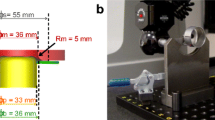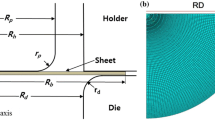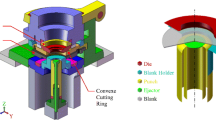Abstract
The prediction of earing during cup-drawing of the anisotropic aluminum alloy Al-6022-T4 is studied through a combination of experiments and analysis. At first, the anisotropy of the material is established experimentally, using uniaxial and plane-strain tension, as well as disk compression experiments. The material is seen to possess mild anisotropy, which however evolves with deformation. Two plastic potentials, Yld89 and Yld2000-2D are then calibrated to that data. The latter potential is flexible enough to represent the experimental plastic work contours almost exactly. Subsequently, the cup-drawing experiments are detailed, including descriptions of the equipment and tooling, measurements during forming as well as measurements of thickness and earing in the drawn-cups. Three analytical models for predicting the maximum drawing force are compared to the experiments. The cups exhibit maximum thinning around the punch-radius, as well as four ears. The ears are oriented along the RD and TD directions, with the TD ears being higher than the RD ones. A simple analytical model is seen to closely capture these results. The experiments are then simulated with shell finite elements in DYNAFORM, which uses the explicit solver of LS-DYNA. The simulations permitted the inverse determination of the friction between the blank and the tooling. The thickness and earing profile predictions from the numerical model are in good agreement with the experiments.




















Similar content being viewed by others
References
Lange K (ed) (1985) Handbook of metal forming, Soc. of Manufacturing Engineers, Dearborn, MI
Tucker GEG (1961) Texture and earing in deep drawing of aluminium. Acta Metall 9:275–286
Jevons JD (1942) The metallurgy of deep drawing and pressing. John Wiley & Sons
Sachs G (1951) Principles and methods of sheet-metal fabricating. Reinhold Pub. Co
Johnson W, Mellor PB (1973) Engineering plasticity. Van Nostrand Reinhold Company, London
Marciniak Z, Duncan JL (1992) Mechanics of sheet metal forming. Edward Arnold, London
Hosford WF, Caddell RM (2007) Metal forming: mechanics and metallurgy. Cambridge Univ. Press, New York
Mamalis AG, Manolakos DE, Baldoukas AK (1997) Simulation of sheet metal forming using explicit finite-element techniques: effect of material and forming characteristics: part 1. Deep-drawing of cylindrical cups. J Mater Process Technol 72:48–60
Comstock RJ, Li K, Wagoner RH (2001) Simulation of axisymmetric sheet forming tests. J Mater Process Technol 117:153–168
Yoon JW, Barlat F, Chung K, Pourboghrat F, Yang DY (1998) Influence of initial back stress on the earing prediction of drawn cups for planar anisotropic aluminum sheets. J Mater Process Technol 80:433–437
Yoon JW, Barlat F, Chung K, Pourboghrat F, Yang DY (2000) Earing predictions based on asymmetric nonquadratic yield function. Int J Plast 16:1075–1104
Moreira LP, Ferron G, Ferran G (2000) Experimental and numerical analysis of the cup drawing test for orthotropic metal sheets. J Mater Process Technol 108:78–86
Yoon JW, Barlat F, Dick RE, Chung K, Kang TJ (2004) Plane stress yield function for aluminum alloy sheets—part II: FE formulation and its implementation. Int J Plast 20:495–522
Stoughton TB, Yoon JW (2005) Sheet metal formability analysis for anisotropic materials under non-proportional loading. Int J Mech Sci 47:1972–2002
Ahn DC, Yoon JW, Kim KY (2009) Modeling of anisotropic plastic behavior of ferritic stainless steel sheet. Int J Mech Sci 51:718–725
Yoon JH, Cazacu O, Yoon JW, Dick RE (2010) Earing predictions for strongly textured aluminum sheets. Int J Mech Sci 52:1563–1578
Park T, Chung K (2012) Non-associated flow rule with symmetric stiffness modulus for isotropic-kinematic hardening and its application for earing in circular cup drawing. Int J Solids Struct 49:3582–3593
Bong HJ, Barlat F, Ahn DC, Kim HY, Lee MG (2013) Formability of austenitic and ferritic stainless steels at warm forming temperature. Int J Mech Sci 75:94–109
Vrh M, Halilovič M, Starman B, Štok B, Comsa DS, Banabic D (2014) Capability of the BBC2008 yield criterion in predicting the earing profile in cup deep drawing simulations. Eur J Mech A Solids 45:59–74
Yoon JW, Barlat F, Dick RE, Karabin ME (2006) Prediction of six or eight ears in a drawn cup based on a new anisotropic yield function. Int J Plast 22:174–193
Aretz H, Barlat F (2013) New convex yield functions for orthotropic metal plasticity. Int J Non Linear Mech 51:97–111
Hill R, Hecker SS, Stout MG (1994) An investigation of plastic flow and differential work hardening in orthotropic brass tubes under fluid pressure and axial load. Int J Solids Struct 21:2999–3021
Kuwabara T, Yoshida K, Narihara K, Takahashi S (2005) Anisotropic plastic deformation of extruded aluminum alloy tube under axial forces and internal pressure. Int J Plast 21:101–117
Korkolis YP, Kyriakides S (2008) Inflation and burst of anisotropic aluminum tubes for hydroforming applications. Int J Plast 24(3):509–543
Korkolis YP, Kyriakides S, Giagmouris T, Lee L-H (2010) Constitutive modeling and rupture predictions of Al-6061-T6 tubes under biaxial loading paths. ASME J Appl Mech 77:64501–1–5
Dick CP, Korkolis YP (2015) Anisotropy of thin-walled tubes by a new method of combined tension and shear loading. Int J Plast 71:87–112
Dick CP, Korkolis YP (2014) Mechanics and Full-Field Deformation Study of the Ring Hoop Tension Test. Int J Solids Struct 51:3042–3057
Barlat F, Brem JC, Yoon JW, Chung K, Dick RE, Lege DJ, Pourboghrat F, Choi S-H, Chu E (2003) Plane stress function for aluminum alloy sheets-part I: theory. Int J Plast 19:1297–1319
Tardif N, Kyriakides S (2012) Determination of anisotropy and material hardening for aluminum sheet metal. Int J Solids Struct 49(25):3496–3506
Aretz H, Aegerter J, Engler O (2010) Analysis of earing in deep drawn cups. In: Proc. NUMIFORM 2010, Pohang, Korea, June 13–17, 2010
Barlat F, Lian K (1989) Plastic behavior and stretchability of sheet metals. Part I: a yield function for orthotropic sheets under plane stress conditions. Int J Plast 5:51–66
Korkolis YP, Kyriakides S (2009) Path-dependent failure of inflated aluminum tubes. Int J Plast 25:2059–2080
Hosford WF (1972) A generalized isotropic yield criterion. ASME J Appl Mech 309:607–609
Logan RW, Hosford WF (1980) Upper-bound anisotropic yield locus calculations assuming <111>−pencil glide. Int J Mech Sci 22:419–430
Beddoes J, Bibby M (2003) Principles of metal manufacturing processes. Butterworth-Heinemann
Backofen WA (1972) Deformation processing. Addison-Wesley Pub. Co
Korkolis YP, Kyriakides S (2011) Hydroforming of anisotropic aluminum tubes. Part II: analysis. Int J Mech Sci 53:83–90
Giagmouris T, Kyriakides S, Korkolis YP, Lee L-H (2010) On the localization and failure in aluminum shells due to crushing-induced bending and tension. Int J Solids Struct 47:2680–2692
Acknowledgments
This research was partially supported by the National Science Foundation GOALI grants CMMI-1031169 and CMMI-1301081. Prof. Haobin Tian acknowledges the support of National Natural Science Foundation of China (Grant No. 51405284). The Al-6022-T4 sheets were provided by Dr. Edmund Chu of Alcoa. We acknowledge the help of Scott Campbell and Vojtech Kubec in machining of the tooling and the specimens and of Daniel Santos in performing some of the measurements.
Author information
Authors and Affiliations
Corresponding author
Rights and permissions
About this article
Cite this article
Tian, H., Brownell, B., Baral, M. et al. Earing in cup-drawing of anisotropic Al-6022-T4 sheets. Int J Mater Form 10, 329–343 (2017). https://doi.org/10.1007/s12289-016-1282-y
Received:
Accepted:
Published:
Issue Date:
DOI: https://doi.org/10.1007/s12289-016-1282-y





